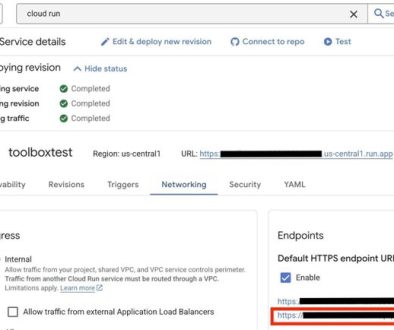GCP – Generative AI for retail: how to keep pace and get ahead
Generative AI marks a significant technological shift. Like the internet or the mobile phone, its potential impact on individual and business productivity is extraordinary. Indeed, 82% of organizations considering or currently using generative AI believe it will either significantly change or transform their industry (Google Cloud Gen AI Benchmarking Study, July 2023).
In retail, the value of generative AI has already begun to show. Organizations are leveraging generative AI to enable and enhance use cases in relevant domains — and, in doing so, reshaping experiences for employees and customers alike.
No technology ever takes away the fundamentals of your value proposition and the core value chain of retail. What can change, though, is how you use this technology to empower your teams to work more productively and meaningfully. With the right tools, you can not only improve core offerings and solve fundamental problems that get in the way of delivering them, but you could even unlock new points of difference for your retail business.
Why generative AI is a gamechanger
Despite the hype around generative AI, this technology is more than a shiny new object — it’s an entirely new value stream for business leaders in retail and beyond. But what makes it different from other forms of AI that have come before?
Put simply, generative AI offers unprecedented ease of use to help solve everyday problems in people’s personal or professional lives. Anyone who knows how to ask a question of a search engine can use everyday language to interact with a generative AI chatbot or virtual agent — getting it to answer questions, create content, produce images, summarize documents, and much more.
Today, leading companies are using generative AI to solve some of their most common and time-intensive problems. According to McKinsey, 75% of generative AI’s value will be realized across customer operations, marketing and sales, software engineering, and R&D.
5 ways generative AI will transform retail
In retail, transformation is more than a requirement. It’s a race.
Your customers are expecting real-time recommendations, subscription models, autonomous stores, on-demand delivery, seamless omnichannel shopping, shopping assistants, customized offers, and more. Generative AI is poised to help you deliver on these expectations, while also delivering internal benefits like productivity gains and a better employee experience.
Here are five powerful applications of generative AI for the retail industry:
1. Creative assistance
With 73% of retail customers expecting brands to just know their preferences, generative AI is helping retailers deliver highly engaging, personalized, and creative content in more cost-effective and timely ways.
Using generative AI to quicklyprototype and create content not only saves time and lowers costs, but it also unlocks new levels of creativity and innovation. With Google Cloud, you can harness generative AI to create highly personalized and relevant content for specific audiences, helping drive better engagement and conversion. You can also test and refine new ideas rapidly, focus on strategy development, and improve customer engagement.
2. Conversational commerce
To drive more sales, retail organizations are turning to generative AI for conversational commerce — building virtual stylists that help consumers find what they need (e.g., “Here are some dresses in your size and style you may like, and images of influencers for style inspiration”). By interactively addressing queries, providing personalized product recommendations, and engaging with customers in real time, these stylists can also influence shopping decisions.
It’s a great way to solve issues like search abandonment. Retailers globally report combined losses of over $2 trillion each year due to this problem, with only 1 in 10 consumers saying they find exactly what they’re looking for when they use a retail website’s search function.
Watch this demo to see how retailers are using generative AI to design personal stylists that can interact with shoppers and provide personalized solutions.
3. Product catalog management
Generative AI transforms how retailers build and maintain product catalogs. You can build studio-grade imagery from simple text prompts, accelerate categorization, and generate great customer-centric marketing copy.
It’s an ideal solve for some of the common problems relating to catalog management — such as getting images from vendors, sorting and categorizing products, and writing product copy. All these things previously took up a lot of time and effort, and compromised the searchability of retail websites. With 92% of consumers more likely to buy a product when they can easily find it, ensuring your products are easily searchable through up-to-date catalogs is key.
Watch this demo to see how retailers are using generative AI to accelerate product catalog management and improve customers’ shopping and search experiences.
4. New product development
Product development and innovation can be faster and more cost-effective with generative AI. You can use it to accelerate research to find insights across multiple data sources, reduce product R&D costs, and zero in on successful product concepts faster. You can enhance internal consumer research with easy querying, summarization, and insight generation. Plus, you can quickly and easily create copy concepts and claims for further testing, and visual concepts for product and packaging designs.
Watch this demo to see how retailers are accelerating product innovation through data-led insights with the help of generative AI.
5. Customer service automation
An invaluable addition to your customer service strategy, generative AI not only supports your customer service reps in real time with helpful answers to customer enquiries, but it can help you scale and optimize other areas of your operations, too. For example, virtual agents can take the load off your contact center. Or, you could use it to summarize conversations and customer service data, and then generate new FAQ content to publish on your website.
With an estimated 75% of customers using multiple channels in their ongoing experience, generative AI helps you extend great customer service across all touchpoints — from digital self-service channels to agent-supported options in branches, call centers, and social media platforms.
Generative AI can enable instant, humanized customer service to help your customers easily and quickly find the answers they need.
Leading brands are reaping the benefits
Already, some of the world’s leading brands are putting the powerful capabilities of generative AI to work in transforming the customer experience.
For example, Wendy’s is piloting cutting-edge generative AI takeout windows in Ohio, helping the fast-food leader free workers to focus on customer experience.
In the beauty industry, The Estée Lauder Companies Inc. and Google Cloud partner to transform the online consumer experience with generative AI.
Hit the ground running with generative AI
When a new technology moves as fast as generative AI, it can be hard to keep up. As a strategic partner to the retail industry, Google Cloud helps chart your path forward with the appropriate frameworks, tools, and governance structures — while ingraining a responsible approach to AI organization-wide.
With generative AI, your retail organization can now simplify how products are onboarded, categorized, labeled for search, and marketed, while creating personalized experiences for your customers. Using simple text prompts, your teams can build detailed product attributes for new SKUs, map them to existing product hierarchies, and create marketing copy, product descriptions, images, videos, and even music, all in the name of driving conversions.
Ready to hit the ground running? Download our eBook, The executive’s guide to generative AI.
About the Google Cloud Generative AI Benchmarking Study
The Google Cloud Customer Intelligence team conducted the Google Cloud Generative AI Benchmarking Study in mid-2023. Participants included IT decision makers, business decision makers, and CXOs from 1,000+ employee organizations considering or using AI. Participants did not know Google was the research sponsor and the identity of participants was not revealed to Google.
Read More for the details.




